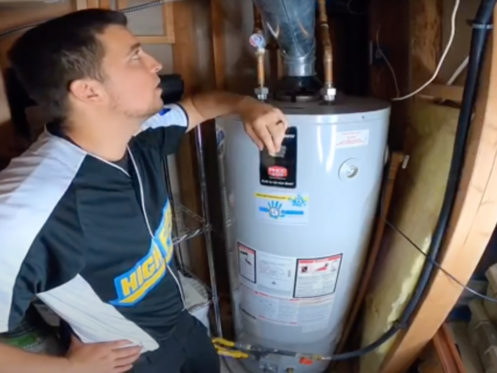Ways to Extend the Life of Your Home's Hot Water System Through Maintenance
Ways to Extend the Life of Your Home's Hot Water System Through Maintenance
Blog Article
Do you find yourself on the lookout for information and facts on Water Heater Maintenance Tips You Can't Afford to Forget?

Warm water is crucial for everyday comfort, whether it's for a revitalizing shower or cleaning dishes. To ensure your warm water system runs effectively and lasts much longer, regular upkeep is essential. This post provides functional pointers and insights on exactly how to keep your home's warm water system to stay clear of disruptions and expensive fixings.
Introduction
Preserving your home's warm water system might appear challenging, yet with a couple of easy steps, you can guarantee it runs smoothly for several years to come. This guide covers whatever from recognizing your warm water system to DIY maintenance pointers and understanding when to employ professional help.
Significance of Keeping Your Warm Water System
Normal upkeep not just expands the life-span of your warm water system but likewise guarantees it runs successfully. Disregarding maintenance can result in decreased effectiveness, higher power costs, and also premature failing of the system.
Indicators Your Warm Water System Demands Maintenance
Knowing when your warm water system requires focus can protect against significant concerns. Look out for signs such as irregular water temperature, unusual noises from the heater, or rusty water.
Flushing the Water Heater
Flushing your water heater eliminates sediment buildup, improving efficiency and prolonging its life.
Checking and Changing Anode Rods
Anode poles protect against deterioration inside the container. Evaluating and changing them when broken is vital.
Facility Problems Needing Expert Assistance
Examples consist of significant leakages, electrical problems, or if your water heater is consistently underperforming.
Regular Specialist Maintenance Advantages
Professional upkeep can consist of complete assessments, tune-ups, and making sure compliance with safety criteria.
Checking and Adjusting Temperature Level Setups
Changing the temperature setups makes sure ideal efficiency and safety and security.
DIY Tips for Maintenance
You can execute a number of maintenance jobs yourself to maintain your warm water system in top condition.
Looking for Leaks
Regularly check pipes and links for leaks, as these can bring about water damages and higher costs.
Comprehending Your Hot Water System
Prior to diving into upkeep tasks, it's helpful to comprehend the basic elements of your hot water system. Generally, this consists of the water heater itself, pipelines, anode poles, and temperature controls.
Month-to-month Maintenance Tasks
Normal monthly checks can aid catch minor problems prior to they intensify.
Examining Pressure Alleviation Valves
Testing the pressure safety valve guarantees it functions appropriately and avoids too much pressure accumulation.
Insulating Pipelines
Protecting warm water pipes minimizes warm loss and can save energy.
When to Call a Professional
While DIY upkeep is advantageous, some concerns require specialist knowledge.
Conclusion
Regular upkeep of your home's hot water system is crucial for efficiency, long life, and cost savings. By adhering to these tips and knowing when to look for professional assistance, you can ensure a trusted supply of hot water without unforeseen interruptions.
How to Maintain an Instant Hot Water Heater
Before tinkering with your hot water heater, make sure that it’s not powered on. You also have to turn off the main circuit breaker and shut off the main gas line to prevent accidents. Also turn off the water valves connected to your unit to prevent water from flowing into and out of the appliance. 2. When you’re done, you have to detach the purge valves’ caps. These look like the letter “T†and are situated on either side of the water valves. Doing so will release any pressure that has accumulated inside the valves while at the same time avoid hot water from shooting out and burning your skin. 3. When the purge valves’ caps are removed, you have to connect your hosing lines to the valves. Your unit should have come with three hoses but if it didn’t, you can purchase these things from any hardware or home repair shops. You can also get them from retail stores that sell water heating systems. Read the user’s manual and follow it to complete this task properly. When the hosing lines are connected, open the purge port’s valves. 4. You should never use harsh chemical cleaners or solutions when cleaning your unit. Make use of white vinegar instead. It should be undiluted and you’ll probably use about 2 gallons. 5. Now flush your water heater. This task should probably take about 40 minutes. We can’t give you specific directions for this because the procedure is carried out depending on the type, model and brand of your heater. With that being said, refer to the user’s manual. 6. When you’re done draining the unit, you have to turn off the purge port valves again. Remove the hosing lines that you earlier installed on each of the water valves. Put the valve caps (purge port) back in their respective places and be very careful so as not to damage the rubber discs that are found inside these caps. 7. Now that everything’s back in place, check your user’s manual again to find out how to reactivate your water heating system. 8. Once it is working, turn one of your hot water faucets on just to let air pass through the heater’s water supply pipes. Leave the tap on until water flows smoothly out of it. https://www.orrplumbing.com/blog/2014/september/how-to-maintain-an-instant-hot-water-heater/

Do you appreciate reading up on How to Maintain Your Water Heater & Prolong its Life? Leave feedback down below. We would be delighted to listen to your ideas about this article. We are looking forward that you visit us again before long. In case you appreciated our blog entry kindly don't forget to share it. I appreciate reading our article about Water Heater Maintenance Tips You Can't Afford to Forget.
This Resource Report this page